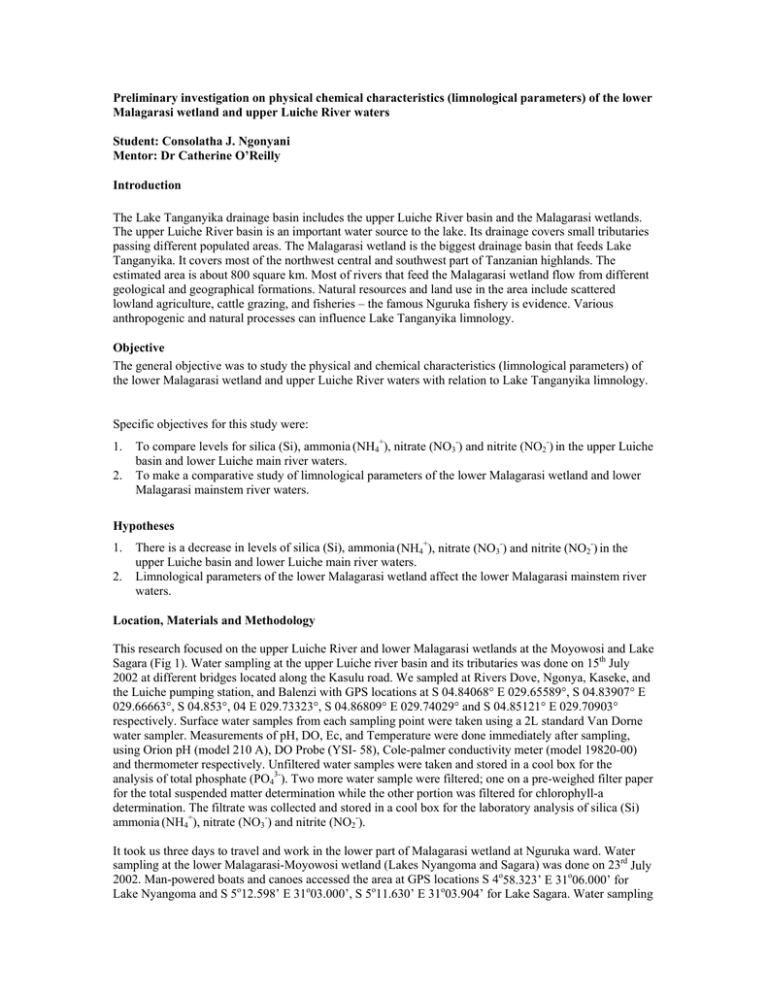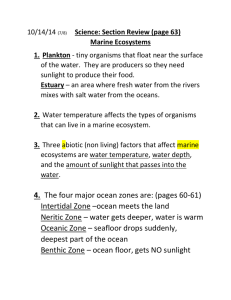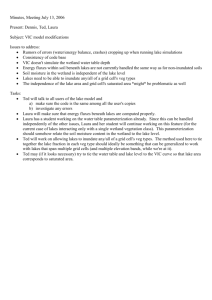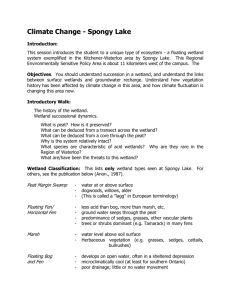Document 10528666
advertisement

Preliminary investigation on physical chemical characteristics (limnological parameters) of the lower Malagarasi wetland and upper Luiche River waters Student: Consolatha J. Ngonyani Mentor: Dr Catherine O’Reilly Introduction The Lake Tanganyika drainage basin includes the upper Luiche River basin and the Malagarasi wetlands. The upper Luiche River basin is an important water source to the lake. Its drainage covers small tributaries passing different populated areas. The Malagarasi wetland is the biggest drainage basin that feeds Lake Tanganyika. It covers most of the northwest central and southwest part of Tanzanian highlands. The estimated area is about 800 square km. Most of rivers that feed the Malagarasi wetland flow from different geological and geographical formations. Natural resources and land use in the area include scattered lowland agriculture, cattle grazing, and fisheries – the famous Nguruka fishery is evidence. Various anthropogenic and natural processes can influence Lake Tanganyika limnology. Objective The general objective was to study the physical and chemical characteristics (limnological parameters) of the lower Malagarasi wetland and upper Luiche River waters with relation to Lake Tanganyika limnology. Specific objectives for this study were: 1. 2. To compare levels for silica (Si), ammonia (NH4+), nitrate (NO3-) and nitrite (NO2-) in the upper Luiche basin and lower Luiche main river waters. To make a comparative study of limnological parameters of the lower Malagarasi wetland and lower Malagarasi mainstem river waters. Hypotheses 1. 2. There is a decrease in levels of silica (Si), ammonia (NH4+), nitrate (NO3-) and nitrite (NO2-) in the upper Luiche basin and lower Luiche main river waters. Limnological parameters of the lower Malagarasi wetland affect the lower Malagarasi mainstem river waters. Location, Materials and Methodology This research focused on the upper Luiche River and lower Malagarasi wetlands at the Moyowosi and Lake Sagara (Fig 1). Water sampling at the upper Luiche river basin and its tributaries was done on 15th July 2002 at different bridges located along the Kasulu road. We sampled at Rivers Dove, Ngonya, Kaseke, and the Luiche pumping station, and Balenzi with GPS locations at S 04.84068° E 029.65589°, S 04.83907° E 029.66663°, S 04.853°, 04 E 029.73323°, S 04.86809° E 029.74029° and S 04.85121° E 029.70903° respectively. Surface water samples from each sampling point were taken using a 2L standard Van Dorne water sampler. Measurements of pH, DO, Ec, and Temperature were done immediately after sampling, using Orion pH (model 210 A), DO Probe (YSI- 58), Cole-palmer conductivity meter (model 19820-00) and thermometer respectively. Unfiltered water samples were taken and stored in a cool box for the analysis of total phosphate (PO43-). Two more water sample were filtered; one on a pre-weighed filter paper for the total suspended matter determination while the other portion was filtered for chlorophyll-a determination. The filtrate was collected and stored in a cool box for the laboratory analysis of silica (Si) ammonia (NH4+), nitrate (NO3-) and nitrite (NO2-). It took us three days to travel and work in the lower part of Malagarasi wetland at Nguruka ward. Water sampling at the lower Malagarasi-Moyowosi wetland (Lakes Nyangoma and Sagara) was done on 23rd July 2002. Man-powered boats and canoes accessed the area at GPS locations S 4o58.323’ E 31o06.000’ for Lake Nyangoma and S 5o12.598’ E 31o03.000’, S 5o11.630’ E 31o03.904’ for Lake Sagara. Water sampling of the rivers was done at different bridges located along the Nguruka road on 24th July 02. We sampled at Malagarasi River-Railway Bridge 1, Ruchugi River, and the Malagarasi River upstream and downstream, before and after the salt mines respectively, at Uvinza ward, with GPS locations at S 5o58.323’ E 30o49.433’, S 5o05.784’ E 30o23.147’, S 5o06.473’ E 30o23.99’ and S 5o06.923’ E 30o22.816’ respectively. Surface water samples from each sampling point were taken by using a 2L standard Van Dorne water sampler. Due to the logistical reasons, only measurements of pH, DO, and temperature were done immediately after sampling. Three liters of unfiltered water sample per each location was taken and stored in a cool box for the analysis of turbidity, Ec, nitrate (NO3-) nitrite (NO2-) silica (Si) phosphate (PO43-) total suspended matter determination and chlorophyll-a determination. Chemical analysis The colorimetric based HACH Analytical procedures for DR/ 2010 were used. Total phosphorous from unfiltered water sample was measured after acid digestion, followed by ascorbic acid addition. The molybdenum blue color complex was formed and with intensity proportional to concentration (method 8191). Total silica from unfiltered water sample was measured in acidic condition by the formation of silicomolybdic acid and phosphomolybdic acid complex, citric acid was used in yellow color complex formation (method 8185). Nitrate was analyzed using the cadmium reduction method followed by the diazonisation (method 8192). Ammonium was made to react with salicylate then oxidized in presence of nitroprusside (method 10023). Nitrite in water samples was reacted with sulfanilic acid to form diazonium salt then coupled with chromatropic acid (method 8507). Results Temperature values for Luiche River and its tributaries ranged from 20.05ºC to 24ºC. The highest and lowest values were from the Balenzi R. and Dove R. respectively. However, the dissolved oxygen values (DO) increased with increase in temperature for the Luiche R. and Balenzi R.. Temperature values increased with pH values . The highest pH value was for Luiche R. and lowest was measured at Dove R. Electric conductivity (Ec) values for Rivers Dove Ngonya and Kaseke were 65, 64 and 65 µS/cm respectively. Values for Luiche River and Balenzi were 245 and 140 µS/cm respectively. Nutrient levels of total phosphorous (TPO43-), nitrogen (TN), and silica (SiO2) for Balenzi R. were the highest followed by Luiche R at the pump station, Kaseke R, Ngonya R and Dove R (Fig 1, Table 1). Temperature values for the Malagarasi wetland and its associates ranged from 25.3 to 21.6 (Table 2). Dissolved oxygen measurements for the Moyowosi wetland, Sagara wetland, Ruchugi River, Malagarasi River. Railway Bridge 1, Malagarasi River downstream,and Malagarasi River Railway Bridge 2 ranged from 3.2 to 7.5 mg/L (Table 2). Higher values were recorded for Lake Sagara. The Malagarasi River Railway bridge1 had very low dissolved oxygen (DO) level that was measured at 3.2 mg/L as compared to other locations . The electric conductivity (Ec) values ranged from 110 - 283 µS/cm (Table 2). The highest value was recorded for the Ruchugi River. Total nitrogen (TN) ranged from 0.01 to 0.199 mg/L (Table 2). Silica (SiO2) levels ranged from 1.8 to 37.300±0.mg/L (Table 2). Values for total phosphate (TPO43-) ranged from 0.12 to 0.740mg/L (Table 2). Discussion Temperature variations among the Luiche River and its tributaries could be due to the difference in sampling time. The rivers were all very shallow (~1m). This means they would heat up rapidly during the daytime. Dissolved oxygen values (DO) increased with increasing temperature for Luiche R. and Balenzi R. Nutrient levels for the upper Luiche River and its tributaries decreased with an increase in distance from the lower Luiche and also as you go downstream, as supported by the findings of Vandelannoote et al (1999). Increased productivity could also have an effect on nutrient levels, whish is supported by the observations by Sako and Makililo (this volume). Compared to the other rivers, large deviations were observed for the Balenzi River. Probably the Balenzi R. drains from larger drainage area. Higher population density and intensive land use could be another reason for excess nutrient load in the Balenzi R. The Dove River had the lowest nutrient levels, probably due to its small size. Temperature variations within the Malagarasi wetland could be due to the difference in location vegetation cover and sampling time. Higher dissolved oxygen values for Lake Sagara could be due to the constant mixing. Low dissolved oxygen for Malagarasi River Railway Bridge1 could be due to the higher BOD load from the Moyowosi wetland drainage area. The high Ec values recorded for Ruchugi River may be because it drains from a highly-populated area. The dry weather conditions might have increased concentration of salts. Nutrients level for the Malagarasi wetland and its associates were expected to decrease with an increase in distance from the lower Malagarasi basin by the dilution effect as supported by Vandelannoote et al (1999). However the Malagarasi upstream from the Uvinza salt mines showed higher nutrient levels than the Malagarasi downstream from Uvinza, where hippos and crocodiles were observed (an indictor of high biodiversity). The nutrient levels seemed to decrease with an increase in productivity for Lake Sagara as opposed to the Moyowosi wetland. The reason could be the morphological and geographical differences. Lake Sagara is located in the lowlands far from mountains hence it is exposed to strong winds. Lake Sagara could experience frequent mixing and strong waves. Frequent mixing could probably cause re-suspension of sediments and nutrients. Nutrients could be transported horizontally further downstream. The Moyowosi wetland (Lake Nyagamoma) behaved differently. Its topography includes small islands of aquatic plants. These islands could act as wind barriers that would protect it from strong waves. Decomposing organic matter deposits could add more nutrients in water column. Cluster data analysis was performed by SYSTAT 7.0 (Kimbandi et al 1999) using single linkages with the metric Euclidean distance as shown in dendograms. The clusters showed that River Balenzi seemed to be distantly linked to the rest of upper Luiche rivers. Linkages for lower Malagarasi wetland showed that Lake Sagara is distantly linked to Lake Nyagamoma. Nutrient data analysis showed that there was a high linkage between TPO43- and TN. Similarly pH and DO showed close linkages. However Ec and SiO2 seemed to be related to other limnological parameters in both systems. Conclusion Results clearly differentiated Lake Sagara from the Moyowosi wetland (Lake Nyagamoma), the Ruchugi from the rest of the Malagarasi River, and the Balenzi from the Luiche River system. This research indicates different water chemistry in the Rivers Balenzi and Ruchugi, and provides insight into the chemistry of the Malagarasi wetland. More investigations that include a larger number of samples are recommended. Acknowledgements Many thanks go to our mentor Dr Catherine O’Reilly for guidance. The geo-limnology team and Maragalasi wetland exploration team that included Mr. Mbatta, Mr. Fidelis Mkililo, Ms. Lindsay, Drs. Hudson Nkotagu and Catherine and Prof. Andrew Cohen, I would also like to appreciate the great support from our TA’s Mr. Kamina Choroka, Mavula Willy Mbemba and R. J. Hartwell. Last but not least to my family for endurance and moral support. Data from Luiche and Malagarasi mainstream courtesy of Aboubakar Sako. Data for turbidity and chlorophyll-a Luiche main stream and Malagarasi wetland were courtesy of Fidelis Makililo. References Vandelannoote A., H. Deelstra, and F. Ollevier. 1999. The inflow of the Rusizi River in Lake Tanganyika. Hydrobiologia 407:65 – 73. A.P.H.A.. 1989. Standard methods for the examination of water and wastewater. 17th Ed, American Public Health Association, Washington D. C. 1587 pp. HACH company. 1992. Water Analysis Handbook (Analytical procedures for DR/2010) 2nd Ed Loveland Colorado USA 831 pp. Kimbandi S., A. Vandelannoote, H. Deelstra, W Mbemba, and F. Ollevier. 1999. Chemical composition of small rivers of northwestern part of Lake Tanganyika. Hydrobiologia 407:75 –80. Figure 1. Map of western Tanzania showing the Luiche and Malagarasi watersheds with major drainages and sampling locations (black circles). Table 1: Data for the Luiche watershed Location Time Distance Temp pH from °C bridge (km) DO (mg/L) - Ec Redox NO3 (mg/L) 3- SiO2 (mg/L) PO4 (mg/L) - NH3-N (mg/L) 2- NO2 (mg/L) SO4 (mg/L) Fe (mg/L) Alkalinity Cl (mg/LCa (mg/L) CO3) o S-04 .84 o E-029 .65 o S-04 .83 Ngonya R. o E-029 .66 o S-04 .85 Kaseke R. o E-029 .73 o S-04 .86 Luiche R.wp o E-029 .74 o S-04 .85 Balenzi R. o E-029 .70 Luiche R. Railway bridge Dove R. Location Myowosi wetland 1 Myowosi wetland 2 Sagara Sagara near shore Ruchugi Malagarasi Bridge Malagarasi upstream Uvinza Malagarasi downstream 10:30 11.7 20.05 7.01 6.36 65 132 0.02 8.1 0.2 0.02 0.016 1 1.62 39.2 5.2 10:58 10.7 22.00 7.88 7.67 64 143 0.07 12.9 0.36 0.02 0.013 3 0.84 24.8 4.4 11:21 8.3 23.00 8.62 8.28 65 126 0.03 13.6 0.66 0.02 0.011 1 0.47 34.4 4 12:00 7.8 23.00 8.44 7.25 245 121 0.07 20.5 0.73 0.01 0.014 1 0.24 103.2 22.4 13:48 7 24.00 8.23 6.50 140 72 0.01 35.8 0.95 0.08 0.019 1 0.83 58 4.4 0 28.50 8.12 7.41 285 0.01 2.2 0.12 0 0 0 0.00 8.93 8 Depth (m) Temp (°C) Secchi pH (m) Ec DO (mg/L) N-NO3 (mg/L) - N-NO2 (mg/L) - 3- SiO2 (mg/L) 2- PO4 (mg/L) SO4 (mg/L) Fe (mg/L) Cl (mg/L) Alkalinity (mg/L CaCO3) o S-4 58.32 o E-31 06.00 8.2 299 7.02 0.08 0.054 37.3 0.71 1 0.13 54.4 119.6 8.2 300 6.8 0.099 0.054 37.5 0.83 1 0.13 51.2 120 8.18 250 7 0.11 0.056 37.1 0.6 1 0.09 57.6 100 8.77 110 7.8 0.14 0.044 13 0.36 1 0.05 10.8 47.6 24.5 24 8.76 8.73 120 115 7.78 7 0.13 0.07 0.058 0.053 14.1 13.7 0.52 0.67 1 1 0.2 0.29 11.2 11.2 45.6 37.2 0 24.4 8.08 145 7.41 0.07 0.055 12.8 0.25 1 0.21 11.2 41.2 0 23.22 8.56 422 7.4 0.15 0.049 16.5 0.45 9 0.42 112 100.8 0 21.6 7.24 185 3.2 0.06 0.055 20.7 0.56 1 0.72 54.4 57.2 S-5 06.47 o E-30 23.9 0 24.4 8.23 175 6.8 0.08 0.057 16.1 0.74 1 0.34 45.6 56.6 S-5o06.92 E-30o22.81 0 25.3 8.25 215 7.2 0.03 0.063 15.6 0.57 2 0.27 64 62.8 S-5o12.59 E-31o03.00 S-5o11.63 E-31o03.90 S-5o05.78 E-30o23.14 S-5o58.32 E-30o49.43 0 23.8 1.25 23.8 0 24.2 0 24.3 1 2 1.25 0.25 o Table 1: Data for the Malagarasi watershed.








